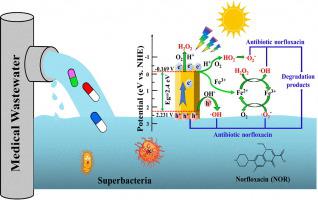Chemical Engineering Journal ( IF 13.3 ) Pub Date : 2021-09-22 , DOI: 10.1016/j.cej.2021.132577 Yong Chen 1 , Yuangang Li 1 , Ningdan Luo 1 , Weike Shang 1 , Shaosen Shi 1 , Huajing Li 1 , Yaodong Liang 1 , Anning Zhou 1

|
In order to eliminate the serious environment pollution and the super bacteria generation caused by antibiotics discharge, it is an urgently challenging task for effective degradation of antibiotics. Many advanced oxidation technologies including Fenton and photocatalytic reactions have been adopted to face with the challenge of this issue. Herein, we developed a H2O2-free photo-Fenton process using BiVO4 as a light absorbing semiconductor with the addition of Fe3+ to degrade antibiotic under a 300 W Xenon lamp and further comparably investigated the kinetics of H2O2-free photo-Fenton and photocatalytic reactions to degrade rhodamine B (Rh B) and rhodamine 6G (Rh 6G). The corresponding reaction mechanism was proposed based on detailed experiments and data analysis. Subsequently using norfloxacin (NOR) as a model, the H2O2-free photo-Fenton reactions were adopted to evaluate the effectiveness of antibiotic degradation with the optimized conditions of pH=3.0 and the Fe3+ concentration of 100 mg/L. The results displayed that the H2O2-free photo-Fenton reaction on BiVO4 conformed to pseudo-first-order kinetics and exhibited excellent antibiotic removing performance, the degradation ratio of NOR reached 96% within 1 h. While its photocatalytic cousin abided by pseudo-zero-order kinetics and its degradation ratio was only 25% with the absence of Fe3+ under the same conditions. It is anticipated that this study can deepen the understanding of mechanism and kinetics between photo-Fenton with photocatalytic reactions on the same catalyst and the expansion of H2O2-free photo-Fenton reactions on other semiconductors has great potential in the treatment of wastewater containing various antibiotics.
中文翻译:

光催化与无 H2O2 光芬顿过程对 BiVO4 的动力学比较和有效的抗生素降解
为了消除抗生素排放造成的严重环境污染和超级细菌的产生,有效降解抗生素是一项紧迫的挑战。许多先进的氧化技术包括芬顿和光催化反应已被采用来应对这一问题的挑战。在此,我们开发了一种使用 BiVO 4作为吸光半导体并添加 Fe 3+在 300 W 氙灯下降解抗生素的无 H 2 O 2光芬顿工艺,并进一步比较研究了 H 2 O 2的动力学无光芬顿和光催化反应降解罗丹明 B (Rh B) 和罗丹明 6G (Rh 6G)。基于详细的实验和数据分析提出了相应的反应机理。随后以诺氟沙星(NOR)为模型,采用无H 2 O 2光芬顿反应,在pH=3.0、Fe 3+浓度为100 mg/L的优化条件下评价抗生素降解效果。结果表明,BiVO 4上的无 H 2 O 2光芬顿反应符合拟一级动力学,表现出优异的抗生素去除性能,1小时内NOR的降解率达到96%。而其光催化表亲遵循拟零级动力学,在相同条件下,在没有Fe 3+的情况下,其降解率仅为25% 。预计该研究可以加深对光芬顿与光催化反应在同一催化剂上的机理和动力学的理解,以及在其他半导体上的无H 2 O 2光芬顿反应的扩展在废水处理方面具有巨大潜力含有多种抗生素。









































 京公网安备 11010802027423号
京公网安备 11010802027423号